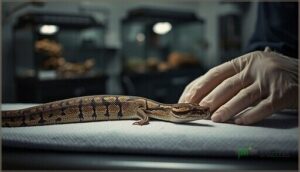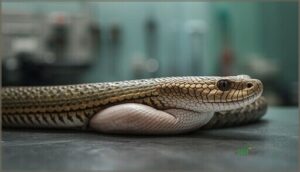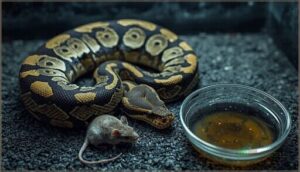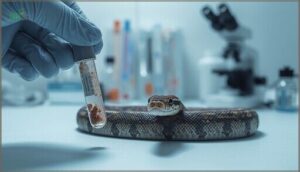This site is supported by our readers. We may earn a commission, at no cost to you, if you purchase through links.
You feed your snake on schedule, maintain perfect temperatures, and follow every care guide to the letter. Then one day, it regurgitates a meal three days after eating—and keeps doing it. That single symptom could signal cryptosporidiosis, a parasitic infection that kills nearly half of untreated snakes and has no reliable cure.
The disease spreads silently through collections, resists most treatments, and forces difficult decisions even for experienced keepers. But catching it early and implementing aggressive supportive care can extend your snake’s life and prevent the parasite from devastating your entire collection.
Table Of Contents
- Key Takeaways
- Recognizing Cryptosporidiosis in Snakes
- Diagnosing Cryptosporidiosis in Snakes
- Treating Cryptosporidiosis in Snakes
- Preventing Cryptosporidiosis in Snake Collections
- Long-Term Management and Prognosis
- Frequently Asked Questions (FAQs)
- What is the best treatment for cryptosporidiosis?
- How long can a snake live with crypto?
- How do you treat Cryptosporidium in animals?
- How to treat cryptosporidiosis in snakes?
- How do you treat Cryptosporidium?
- What is the best way to remove Cryptosporidium?
- What kills cryptosporidiosis?
- What is the typical incubation period for cryptosporidiosis in snakes?
- Can cryptosporidiosis in snakes be transmitted to other reptiles?
- Are there any known risk factors for cryptosporidiosis in snakes?
- Conclusion
Key Takeaways
- Cryptosporidiosis kills nearly half of untreated snakes and has no reliable cure, making early detection through symptoms like regurgitation (81.4% of cases) and mid-body gastric swelling critical for survival.
- Paromomycin at 100-360 mg/kg combined with aggressive fluid therapy and assisted feeding offers the best treatment approach, though fewer than half of snakes clear the infection and relapses remain common.
- Prevention through strict 90-day quarantine protocols, dedicated equipment for each snake, and proper disinfection using 6% hydrogen peroxide or steam cleaning at 176°F is more effective than any treatment option.
- Euthanasia becomes the humane choice when snakes lose more than 25% body weight, continue regurgitating after three weeks of treatment, or refuse food entirely, as recovery at that stage is unlikely.
Recognizing Cryptosporidiosis in Snakes
Spotting cryptosporidiosis early can make the difference between managing the disease and losing your snake. The symptoms aren’t always obvious at first, and they can look a lot like other digestive problems.
Here’s what you need to watch for so you can catch it before it progresses.
Common Symptoms and Clinical Signs
Anorexia onset strikes up to 70% of infected snakes, usually appearing 2 to 4 weeks before other symptoms emerge. Weight loss develops in 80% of cases—adult snakes can drop 20% of their body mass within two months. Diarrhea severity varies, affecting 55% of diagnosed snakes with watery, sometimes bloody stool. Lethargy impacts 65% of cases, while untreated cryptosporidiosis carries a 46% mortality rate within twelve months.
Transmission often occurs through fecal-oral contact, highlighting the importance of hygiene.
Regurgitation and Gastric Swelling
Regurgitation hits 81.4% of infected snakes, usually 1 to 3 days after feeding. You’ll notice a firm, midbody swelling—gastric mucosal hyperplasia thickens the stomach wall and disrupts gastric motility. This clinical progression is stark: snakes showing both signs face mortality rates exceeding 80%.
Regurgitation and midbody swelling strike over 80% of infected snakes, with combined symptoms pushing mortality past 80%
Wild prevalence reaches 46.2%, underscoring how cryptosporidiosis spreads. Treatment options remain limited, making early recognition crucial. Euthanasia is a valid option, especially in severe cases of reptile parasitic diseases.
Anorexia, Weight Loss, and Diarrhea
Once gastric swelling sets in, chronic anorexia follows in up to 70% of symptomatic cases—adult snakes refuse food as gastric colonization wrecks nutrient absorption. Weight reduction becomes visible within weeks, often paired with mucoid diarrhea that signals advancing fatal gastritis.
Here’s what you’ll observe:
- Refusal to eat for 3+ consecutive feedings
- Progressive thinning along the spine and ribs
- Loose, watery, or blood-tinged stool
- Lethargy coinciding with rapid decline
These combined signs demand immediate diagnosis of Cryptosporidiosis and treatment.
Differentiating From Other Gastrointestinal Diseases
The challenge with diagnosing cryptosporidiosis lies in symptom overlap—regurgitation, weight loss, and diarrhea also occur with bacterial infections, parasites, and viral gastritis. What sets cryptosporidiosis apart is mid-body gastric swelling, a distinctive clinical sign rarely seen in other gastrointestinal diseases.
PCR testing of fecal samples and gastric lavage offers a definitive diagnosis, differentiating cryptosporidiosis from mimicking conditions.
Species manifestations matter too: C. serpentis causes gastric hypertrophy with visible swelling, while C. varanii commonly triggers enteritis without prominent gastric changes, guiding your diagnostic approach.
Diagnosing Cryptosporidiosis in Snakes
Getting the right diagnosis is your first real step toward saving your snake’s life. When cryptosporidiosis is suspected, your vet will use several diagnostic tools to confirm what you’re dealing with and how severe it is.
Here’s what that process usually looks like.
Physical Examination and Medical History
Catching cryptosporidiosis early hinges on connecting the dots between your snake’s history and what you observe. When you bring your snake in, your vet needs to know the full story. Here’s what matters most:
- Prior regurgitation episodes, especially after feeding
- Documented chronic weight loss despite adequate food intake
- Palpable swelling in the midbody during physical exam
- Exposure risks from new or wild-caught reptiles
- Anorexia onset and behavioral changes like lethargy
These clinical signs paint the diagnostic picture your vet needs to confirm cryptosporidiosis and start treatment.
Gastric Lavage and Biopsy Techniques
When fecal samples keep coming back negative, gastric lavage becomes your diagnostic workhorse. You’ll anesthetize your snake and insert a flexible tube into the stomach, collecting washings for PCR analysis—a technique that achieves up to 94.4% sensitivity for detecting Cryptosporidium serpentis.
For snakes over 75 grams, gastric biopsy offers another option, though complications like regurgitation and tissue trauma require careful anesthesia protocols and aseptic technique to minimize procedural risks.
Imaging and Bloodwork for Assessment
After gastric lavage, imaging provides a comprehensive view of internal conditions. Radiographic contrast studies reveal thickened gastric walls exceeding 1 cm, while ultrasound detects mucosal thickening and concentric rings characteristic of infection. Bloodwork assesses hydration and organ function, though findings remain non-specific. Together, these multimodal approaches—combining X-rays, ultrasound, and molecular diagnostics—distinguish cryptosporidiosis from other gastrointestinal diseases, guiding your treatment strategy.
- Barium sulfate radiography identifies gastric hypertrophy and abnormal lumen size
- Serial ultrasound monitoring tracks disease progression and treatment response
- PCR testing confirms infection with precise species identification
Treating Cryptosporidiosis in Snakes
Once your vet confirms cryptosporidiosis, treatment shifts from diagnosis to action—and here’s what matters: there’s no magic cure, but the right approach can make a real difference.
Your snake needs aggressive supportive care combined with targeted medication, and you’ll be managing several things at once. Let’s walk through what that actually looks like in practice.
Supportive Care and Fluid Therapy
Your infected snake can’t fight crypto without proper hydration and nutritional support—that’s where supportive care becomes critical. Fluid therapy stabilizes severely dehydrated snakes, helping prolong survival when paired with intensive treatment options.
| Fluid Types | Administration Methods |
|---|---|
| Lactated Ringer’s (20 mL/kg) | Subcutaneous injection |
| Normosol-R (10 mL/kg) | Oral rehydration |
| Saline solution (2% body weight) | Gastric lavage |
| Balanced electrolyte solutions | Intracoelomic delivery |
Monitoring efficacy through weight checks and stool consistency helps gauge recovery. Co-management with prognosis factors determines whether your snake will respond or require euthanasia.
Use of Paromomycin and Other Medications
Paromomycin remains your best shot against cryptosporidiosis in snakes, though it rarely achieves full eradication. Standard treatment options start at 100 mg/kg daily for seven days, then twice weekly for three months.
- Higher paromomycin dosages (360 mg/kg) show better efficacy in early infections
- Drug resistance hasn’t surfaced widely, but relapses occur after immunosuppression
- Combination therapies with spiramycin or metronidazole disappoint consistently
- Bovine colostrum (1% body weight weekly) reduces oocyst shedding in some cases
- Safety profiles favor paromomycin over toxic ionophores like halofuginone
Nutritional Support and Assisted Feeding
When your snake won’t eat, assisted feeding becomes critical to survival. Gastric gavage delivers liquid diets at 1–2% body weight, usually twice daily, without triggering regurgitation.
Enteral nutrition using formula feeds aids hydration and slows weight loss. Fluid supplementation at 1–3% body weight daily prevents dehydration.
Add vitamin supplementation—especially D3, A, and calcium—since diseased guts can’t absorb nutrients effectively. Monitor support through weekly bloodwork and body weight tracking.
Managing Secondary Infections
Beyond nutrition, cryptosporidiosis opens the door to serious coinfection risk factors—bacteria and fungi thrive when immunity drops. Routine screening catches these threats early. Antimicrobial resistance is common, so culture-guided combination therapies work best. Fungal complications need targeted antifungals like itraconazole. Prevention means strict hygiene, isolation, and weekly monitoring to stop secondary infections before they compound your snake’s diagnosis and derail treatment.
- Culture bacterial and fungal samples to guide antibiotic choice
- Use enrofloxacin for Aeromonas secondary infections
- Apply itraconazole or voriconazole for fungal complications
- Combine antimicrobials when multiple pathogens are present
- Monitor weekly for emerging secondary infections
Preventing Cryptosporidiosis in Snake Collections
Prevention is always better than treatment for cryptosporidiosis in your snake collection. The key is stopping the parasite from entering your collection in the first place and keeping it from spreading if an infection does occur.
Let’s look at the essential practices that protect your snakes from this dangerous disease.
Quarantine Protocols for New Arrivals
To stop Cryptosporidiosis before it devastates your collection, you must quarantine every new snake for at least 90 days—though many experts recommend extending this to 18–24 months. Testing Strategies should include monthly PCR tests and multiple fecal samples since shedding is intermittent.
Equipment Dedication is critical: use separate tools exclusively for quarantine animals. Monitoring Records help track subtle changes. Unfortunately, Failure Rates remain high when protocols aren’t followed rigorously.
Isolation of Infected Individuals
Once you’ve confirmed an infection, immediate segregation becomes your most powerful weapon. You’ll need to physically separate infected snakes to prevent the disease
Effective Disinfection and Sanitation Methods
from spreading further. But separation alone won’t stop Cryptosporidium—you need to destroy the oocysts themselves.
Standard cleaners won’t cut it. Oocysts resist bleach, phenols, and most household disinfectants. Instead, use 6% hydrogen peroxide for 20 minutes or ammonia (diluted 1:2) for 18 hours. Steam cleaning at 176°F for two minutes works beautifully. Freezing and desiccation also break the cycle.
Always pre-clean with hot, soapy water before disinfection—it makes everything more effective.
Dedicated Tools and Hygiene Practices
Without proper tool segregation, you’ll spread Cryptosporidium faster than you can contain it. Dedicate separate tongs, bowls, and gloves exclusively to infected or quarantined snakes.
Hand hygiene matters—wash with soap between every animal, not just sanitizer. Follow strict cleaning protocols: hot water first, then disinfectants like hydrogen peroxide.
Single-use items prevent cross-contamination better than any bleach routine can.
Long-Term Management and Prognosis
Treating cryptosporidiosis doesn’t end when you start medication—what happens over the weeks and months ahead often determines whether your snake survives. You’ll need to stay alert for signs of improvement or decline, make adjustments to minimize stress, and honestly assess whether treatment is working or causing more harm.
Here’s what you should know about managing a crypto-positive snake for the long term.
Monitoring Recovery and Disease Progression
Tracking your snake’s recovery requires consistent clinical sign monitoring paired with molecular verification. Watch for reduced gastric swelling, decreased regurgitation frequency, and improved appetite as positive indicators.
PCR testing every 2–4 weeks initially, then quarterly, confirms parasite clearance—don’t rely on clinical signs alone, since remission can mask relapse.
Weigh your snake regularly; unexplained weight loss signals ongoing cryptosporidiosis. Expect 18–36 months of testing before declaring true resolution and safe reintegration.
Reducing Stress and Optimizing Husbandry
Optimizing your snake’s environment directly impacts recovery outcomes. Adequate enclosure enrichment—branches, shelters, proper spacing—reduces stress-related immune suppression by 35–60%.
Minimize handling to fewer than four times monthly, keeping social density below two snakes per cubic meter. Maintain consistent temperatures and humidity.
Provide species-appropriate nutrition and clean water below 1 CFU/ml contamination. These husbandry adjustments strengthen your reptile’s defenses against cryptosporidiosis progression.
When to Consider Euthanasia
When your snake’s condition doesn’t improve within three weeks of treatment, it’s time to reassess. If regurgitation persists, weight loss exceeds 25% of body mass, or your snake refuses food entirely, you’re facing end-stage disease. Most snakes in this state don’t recover.
Euthanasia becomes the humane choice—a protocol that prevents prolonged suffering and protects your collection from ongoing transmission risk. Consult your veterinary herpetologist about timing and method.
Biosecurity Measures for Ongoing Control
Prevention hinges on breaking the transmission cycle. You’ll need strict handler hygiene—soap and water, not alcohol sanitizers, since they don’t kill oocysts.
Implement molecular surveillance through regular PCR screening to catch subclinical infections early.
Your outbreak response protocol should trigger immediate quarantine and compliance monitoring of sanitation schedules.
Steam-clean enclosures at 80°C or use 6% hydrogen peroxide for 20 minutes to achieve reliable oocyst inactivation. This isn’t optional—cryptosporidiosis remains contagious long after symptoms fade.
Frequently Asked Questions (FAQs)
What is the best treatment for cryptosporidiosis?
Managing this challenging infection requires a multi-pronged approach. Paromomycin dosing at 100 mg/kg daily, combined with supportive care like fluid therapy and nutritional support, helps control symptoms.
Alternative therapies and monitoring secondary infections improve long-term outcomes.
How long can a snake live with crypto?
Your snake’s survival with Cryptosporidiosis depends on several factors. Some infected snakes live as asymptomatic carriers for years, while symptomatic cases generally progress to death within months to two years without effective treatment.
How do you treat Cryptosporidium in animals?
Treatment for Cryptosporidium varies widely across species. Calves and lambs respond well to paromomycin at 100-200 mg/kg for 2-5 days alongside fluids, while immunocompromised pets need aggressive supportive therapy and strict zoonotic precautions.
How to treat cryptosporidiosis in snakes?
Your vet will likely prescribe paromomycin at 100 mg/kg daily for 10 days, then twice weekly for 90 days.
You’ll also need to provide fluid therapy, assisted feeding, and monitor for secondary infections carefully.
How do you treat Cryptosporidium?
You’ll often hear it’s “incurable,” yet paromomycin at 360 mg/kg twice weekly for six weeks does reduce Cryptosporidium loads in snakes—though fewer than half clear the infection, and recurrence prevention remains frustratingly elusive.
What is the best way to remove Cryptosporidium?
Complete removal from enclosures demands hydrogen peroxide (6% for 20 minutes) or heat inactivation via steam cleaning at 80°C. PCR verification confirms success.
Note disinfectant limitations—bleach alone won’t eliminate Cryptosporidium oocysts effectively.
What kills cryptosporidiosis?
Think of Cryptosporidium as a fortress—medications like Paromomycin (at 360 mg/kg), hyperimmune bovine colostrum therapy, and halofuginone can breach its defenses.
Disinfection agents including 5-6% hydrogen peroxide destroy oocysts in your snake’s environment.
What is the typical incubation period for cryptosporidiosis in snakes?
The incubation period for cryptosporidiosis in snakes usually spans 2 to 10 days, with most symptom onset occurring within 5 to 7 days after exposure to the parasite.
Can cryptosporidiosis in snakes be transmitted to other reptiles?
Yes, cryptosporidiosis is highly contagious among reptiles. Infected snakes can transmit the disease to lizards, turtles, and other snakes through direct contact or contaminated equipment, making mixed collections particularly vulnerable to outbreaks.
Are there any known risk factors for cryptosporidiosis in snakes?
Several factors increase cryptosporidiosis risk in snakes. Poor sanitation conditions, housing with other reptiles, and stress-related immunosuppression increase infection rates. Adult snakes over three years old face higher susceptibility.
Wild snakes show considerably greater infection prevalence than captive populations.
Conclusion
Saying goodbye to an infected snake isn’t failure—it’s sometimes the most responsible call you’ll make. Understanding how to treat cryptosporidiosis in snakes means accepting that prevention and early detection outweigh every treatment attempt.
Your diligence in quarantine, sanitation, and monitoring protects the animals you’ll care for tomorrow. The parasites don’t rest, but neither should your commitment to biosecurity. One slip undoes years of careful stewardship.
- https://pubmed.ncbi.nlm.nih.gov/40677561/
- https://journals.asm.org/doi/10.1128/AEM.70.2.891-899.2004
- https://tvmdl.tamu.edu/case-studies/cryptosporidium-serpentis-in-snakes/
- https://www.sciencedirect.com/science/article/pii/S0304401797001532
- https://bioone.org/journalArticle/Download?urlid=10.5818%2FJHMS-D-21-00010















